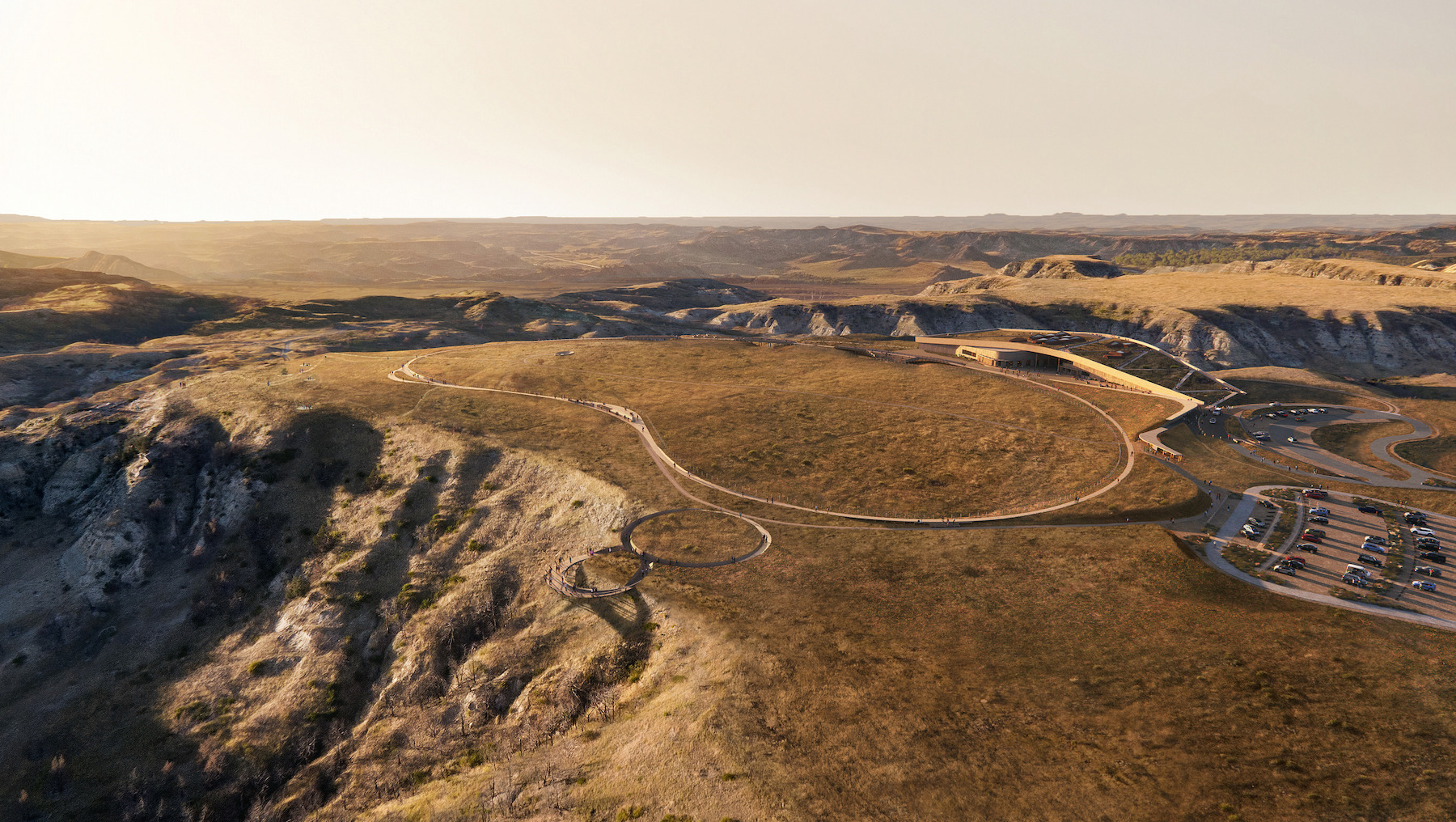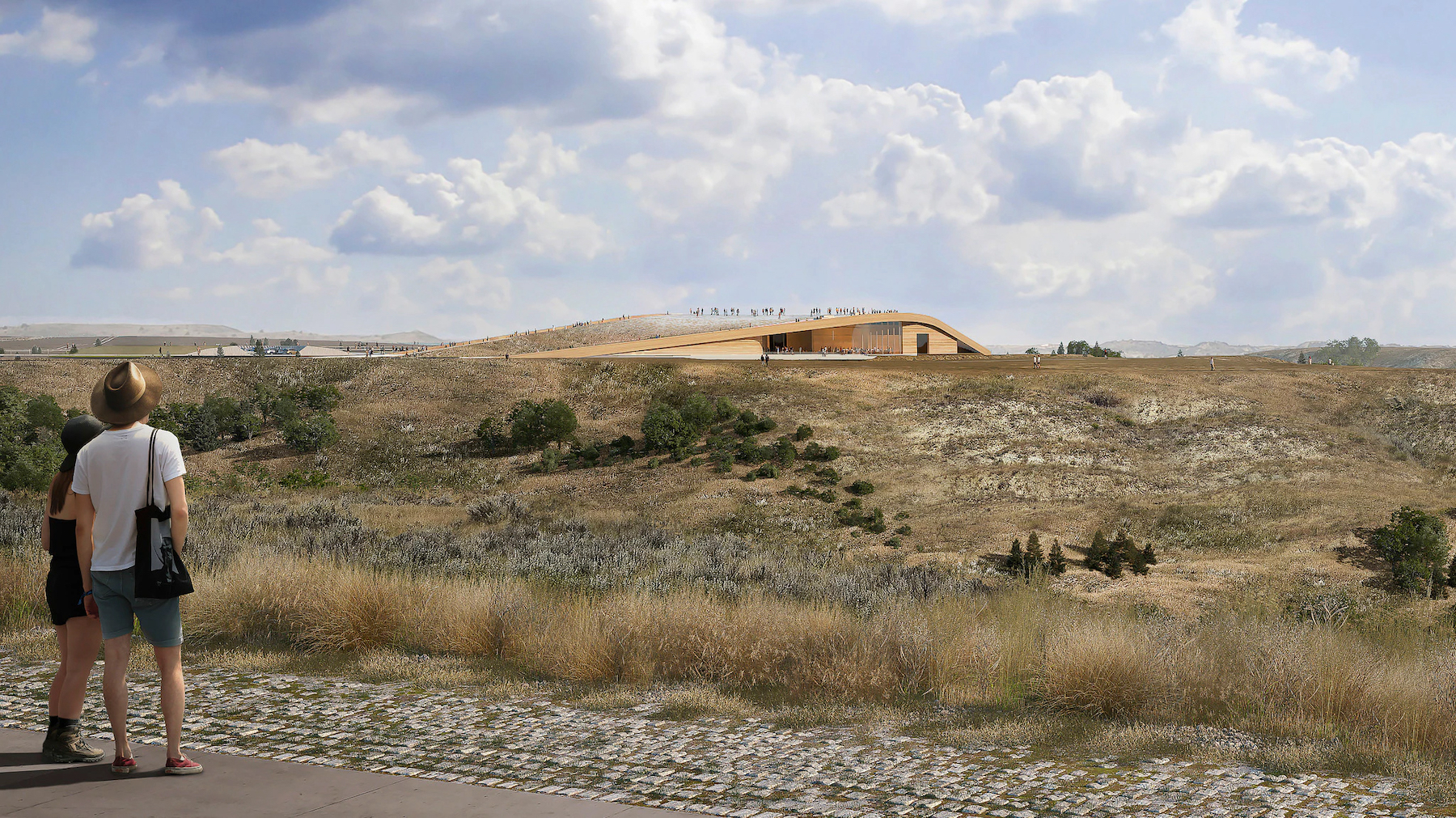On July 4, 2026, the Theodore Roosevelt Presidential Library is scheduled to open on 93 acres in Medora, a town in North Dakota with under 130 permanent residents, but which nonetheless has become synonymous with the 26th President of the United States, who lived there for several years in the 1880s.
The under-construction $333 million library, situated on a Badlands butte near the Burning Hills Amphitheater, will not be a repository for Roosevelt’s papers or archives (which are mostly housed at Harvard University). Instead, the library’s goal is to honor the President’s legacy as a conservationist. Its design is informed by Roosevelt’s interest in environmental stewardship and his reflections about the landscape.
The single-story, 93,000-sf library/museum “is a journey preserving the existing landscape of diverse habitats punctuated with small pavilions allowing for reflection and activity,” according to the project’s website. “The main building’s gently sloping roof looks to the northeast, gazing out to the [70,447-acre] National Park, historical settings in the Little Missouri River valley, and the Elkhorn Ranch far in the distance, further connecting the Library of tomorrow with its origins of the past.”
“The Library is the landscape,” Edward O’Keefe, CEO of the Theodore Roosevelt Presidential Library, told the New York Times.
Mass timber complements construction

Mass timber is a significant component in the construction of the Library. The Mercer Mass Timber subsidiary of Mercer International is providing nearly 1,800 cubic meters of cross-laminated timber and glulam––harvested from sustainably managed forests––which are being used for the building’s structure that includes a green walkable roof, as well as a one-mile-long boardwalk loop in front of the Library that aligns with the roof’s curvature.
The green roof aims to restore the vegetation disrupted within the building’s footprint, and to create a habitat for native plants. The Library is sponsoring this Native Plant Project in partnership with Resource Environmental Solutions, the nation’s largest ecological restoration company; and North Dakota State University.
Within the Library there will be “narrative galleries,” as well as community spaces, a café, and an auditorium, which the Times pointed out would be large enough to host candidate debates during presidential election campaigns.
The Library “represents a transition we’re seeing in modern library and architectural design, where community spaces are being constructed with long-term sustainability in mind,” said Nick Milestone, Mercer’s Vice President of Projects and Construction, in a prepared statement.
In partnership with the project’s general contractor JE Dunn Construction, Mercer is providing mass timber design assistance, materials, and coordination and logistics. Other AEC firms involved in this project: Snøhetta (design and landscape architect), JLG Architects (AOR), Seagate (mass timber installation), Magnusson Klemencic Associates (Engineer of Record), and Command Industires (steel subcontractor).
The Library––which is four and a half hours north of Mount Rushmore and seven hours northeast of Yellowstone National Park––is targeting LEED Platinum and Living Building Challenge certifications. Its goal is to be net-zero energy, emissions, water, and waste.
Related Stories
| Aug 11, 2010
Harvard Public Library
Harvard, Mass.
Five years ago, the town of Harvard, Mass., which lies about 30 miles west of Boston, faced two problems. First, its iconic public schoolhouse, known as Old Bromfield, which was built in 1877, had become outdated. So, too, had its public library, which had no room to grow on its site.
| Aug 11, 2010
Gilbane, Whiting-Turner among nation's largest university contractors, according to BD+C's Giants 300 report
A ranking of the Top 50 University Contractors based on Building Design+Construction's 2009 Giants 300 survey. For more Giants 300 rankings, visit /giants
| Aug 11, 2010
AASHE releases annual review of sustainability in higher education
The Association for the Advancement of Sustainability in Higher Education (AASHE) has announced the release of AASHE Digest 2008, which documents the continued rapid growth of campus sustainability in the U.S. and Canada. The 356-page report, available as a free download on the AASHE website, includes over 1,350 stories that appeared in the weekly AASHE Bulletin last year.
| Aug 11, 2010
Burt Hill, HOK top BD+C's ranking of the nation's 100 largest university design firms
A ranking of the Top 100 University Design Firms based on Building Design+Construction's 2009 Giants 300 survey. For more Giants 300 rankings, visit http://www.BDCnetwork.com/Giants
| Aug 11, 2010
Jacobs, HDR top BD+C's ranking of the nation's 100 largest institutional building design firms
A ranking of the Top 100 Institutional Design Firms based on Building Design+Construction's 2009 Giants 300 survey. For more Giants 300 rankings, visit http://www.BDCnetwork.com/Giants
| Aug 11, 2010
College uses renewable materials in new library
A 93,000-sf Library and Academic Resource Center will replace Los Angeles Valley College's 1960s-vintage library. Pfeiffer Partners Architects designed the building to be consistent with the college's master plan, with its learning clusters and arcade circulation system. To obtain LEED certification, the center will use recycled and renewable materials, such as bamboo.
| Aug 11, 2010
Northeast Lakeview College opens in Texas, to serve 15,000 students
After four years of construction, Northeast Lakeview College, the newest addition to Alamo Colleges, is complete. Designed by Overland Partners Architects in collaboration with Ford Powell & Carson, the nine-building, 285-acre campus in Universal City, near San Antonio, will serve up to 15,000 students.







